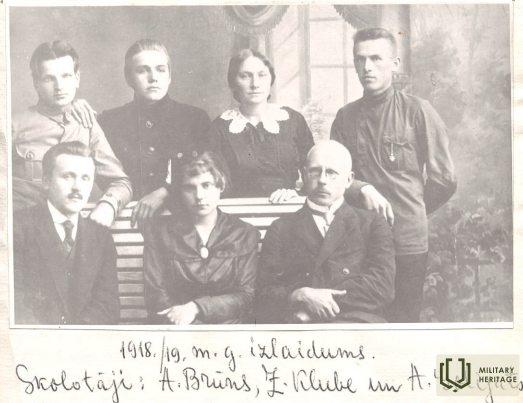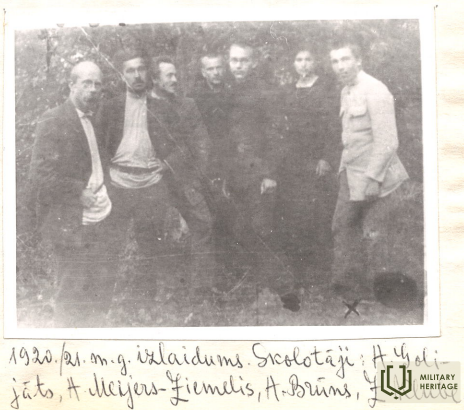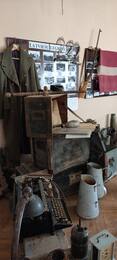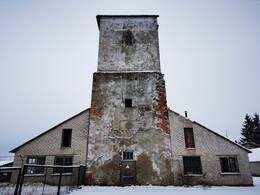How the men of the Latvian government fooled the co-runners of the Pampali Bolsheviks
The former director of the Pampāli school (until 1959) Alfred Brūns has hand-printed an impressive book about the history of the Pampāli school and historical events around it with authentic photographs. In the book, A. Brūns describes the events of the War of Independence in Pampāli, describing in detail the events involved both Latvian statesmen, Bolshevik supporters, actions of the German army, etc.
[…] 1919
In 1919, around January 6, the members of the Latvian government and the People's Council fled towards Liepāja by different routes, avoiding the Bolshevik streams flowing in the direction of Venta.
A former student of ours (1914 [school graduate]), Žanis Kummermanis, had organized a group of Bolsheviks in the Pampāli estate and it already ruled Pampāli several days before the Soviet troops appeared in Pampāli.
Pampāļnieks Fricis Vecpuisis - the owner of the Stunguri houses - the head of the war construction department of the Ulmani government - an officer with some other Latvian state employees, while retreating to Liepāja, had entered "Stunguris" in a good, government-requisitioned limousine to spend the night. A group of Pampali partisans, informed about this, immediately came to "Stunguros" to take the limousine to Pampali. The old man didn't resist - as long as he took it, because he couldn't get any further anyway, the petrol had run out to the last drop. The simple servants of the manor believed and went to Pampālii with such a message. Having found out what kind of official Vecpuisis is there, in the early morning they left with 4 or 6 of the best horses to transfer the car. Neither the limousine, nor Vecpuis, nor other government men were found in "Stunguros".
In the archive, there is news that Fricis Vecpuisis, born in 1890, Stunguri house, was deported on June 14, 1941.
Level/Level: Case Number/Number: 20035
==================
The former director of the Pampali school (until 1959) Alfred Brūns has hand-printed an impressive book about the history of the Pampali school and historical events around it, with authentic photographs. The book is located in Pampāli with Artūrs Hartmani, who owns an impressive private collection of various antiquities and World War 2 artifacts found in the surroundings of Pampāli.
Latvian State Archives (rtu.lv)
www.itl.rtu.lv/LVA/index3.php?id=9009&kods=14072&vien=5
Related timeline
Related objects
Pampali church and the walls of the destroyed house
Pampāļi is a settlement in Pampāļu parish of Saldus county, the center of the parish is on the banks of Zaņas and its tributary Abrupe, 27 km from the county center Saldus and 147 km from Riga. The settlement was formed around the center of Pampāli manor after the agrarian reform. In 1933, Pampālis was granted the status of a densely populated place.
The hostilities on the outskirts of the Pampali began on November 21, 1944, when the Soviet 4th shock army, forcing Venta, began an attack in the direction of Saldus. By November 24, the situation stabilized and the front line remained unchanged until December 21.
On December 21, 1944, the so-called 3rd Battle of Kurzeme began, during which the 4th shock army of the 1st Baltic Front with 4 rifle corps (12 rifle divisions) and the 3rd Guards Mechanized Corps attacked in the direction of Saldus to connect there with the 2nd Baltic Front units. The German 132nd Infantry Division, whose 1st Battalion of the 436th Grenadier Regiment had fortified itself in the vicinity of the manor and the church, was defending itself in the Pampali district.
The attack on Pampāliai was carried out under the support of massive artillery fire by the 357th and 145th Rifle Divisions of the 1st Rifle Corps, supported by the 39th Guards Tank Brigade. During the first 24 hours of the battle, the Pampali garrison, commanded by the commander of the 14th (Anti-Tank) Company of the 436th Grenadier Regiment, Captain Eberard Coll, was encircled and virtually destroyed in fierce fighting.
Since Pampali was located right on the front line, all the buildings were hit by artillery fire and practically have not been preserved today.










